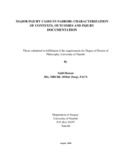| dc.description.abstract | Background: Trauma accounts for one tenth of the total burden of disease globally with the greatest burden and the worst outcomes being recorded in developing countries which also experience scarcity of trauma data. The few studies undertaken in Kenya suggest an escalating problem associated with high injury mortality rates. Delineating contexts of injury and establishing aspects of care linked to outcomes would define the priority areas for preventive action aimed at trauma care improvement.
Objectives: The aim of this study was to characterize the contexts and outcomes of injury and describe the effectiveness of a documentation system for major trauma in Nairobi.
Study areas: Kenyatta National Hospital (KNH) and the Nairobi City County Mortuary (NCCM).
Study design: Prospective non-registry and registry based observational study of patients admitted to hospital and trauma deaths received at the mortuary between November 2009 and September 2013. The study was done in three phases. Phase I evaluated the non-registry hospital admissions while phase II analyzed consecutive trauma autopsies. Phase III entailed the establishment and assessment of quality of a trauma registry at the KNH. The study involved 1,647 patients in phase I, 237 fatalities in phase II and 338 patients in phase III.
Study methods: In phase I, demographic, causes, time, space, event, body region distribution, injury severity score and injury treatment data were collected and analyzed in relation to lengths of hospital stay, utilization of resources, cost of treatment and mortality. Phase II involved observations on trauma autopsies performed over one year. Mortuary cases were compared with hospital deaths for age and gender of victims, intent, causes, time and anatomical regions of injuries. Phase I data were used to define the core data set for development of a computerized
trauma registry which was evaluated in phase III for accuracy and reliability in depicting injury events and outcomes.
Data Analysis: The data gathered were entered into a computer and analyzed with the use of Statistical Package for Social Sciences (version 21, SPSS Inc.) The Student’s t-test and Chi square test were respectively used to compare continuous and categorical data while Analysis of variance (ANOVA) was used to compare the means of several groups. Mann-Whitney- U or Kruskall-Wallis tests were used for comparisons of cost and length of stay data which were skewed. Logistic regression was used to test which ones of several variables significant at univariate analysis independently predicted outcomes. P value < 0.05 was considered significant. Injuries with injury severity scores (ISS) > 15 were considered as major injuries and the results obtained presented in the form of tables and charts.
Results: Trauma patients in the study were generally young (mean age 31.4 + 15 years, 29.8 +12.2 years and 25.64 1+7 years in phase I,II and III respectively) with a predominance of males (82.3% in phase I, 89.5% in phase II and 81.0% in phase III). The leading causes of trauma admissions were road traffic injuries, assault, falls and burns. Pedestrians formed 43.3% of RTI admissions while motorcycle trauma accounted for 22.6% of vehicular injuries. Injuries due to violence were significantly associated with night-time occurrence and primary admissions. The average ISS, proportion of injuries of ISS > 15, median length of stay was 6.86, 10.9% and 12 days in phase I but 18.8, 64.7% and 19 days in phase III. Median cost of treatment was 242 US$ and 310 US$ in the two phases respectively. Treatment costs and length of stays were higher for unintentional injury.
The overall mortality rate for the study population was 7.6% and 16.0% in phase I and III respectively. ICU, surgery, transfusion and in-hospital mortality rates were 27.3%, 46.5%, 44.6% and 29.5% for patients who sustained major injuries. Overall, low Glasgow Coma Score (GCS) and severe injuries (of ISS > 15) were independent predictors of mortality on regression analysis.
The most common body regions injured were the extremities and head/neck. The head was the predominant region of injury in fatalities. Compared to in-hospital deaths, a larger proportion of pre-hospital deaths captured at the mortuary were caused by intentional injuries (59.4% versus 26.7%), gunshot mechanism (25.7% versus 7.5%) and occurred at night.
In the case of the registry, stakeholder identification, core data definition and training for data collection allowed the establishment of a flexible KNH registry. The registry was found to be reliable in depicting demographic features, injury intent, causes and process metrics. The depiction of mortality and severe injury rates using the ISS was less reliable.
Conclusion: The study has shown that:
(i) traffic and assault were the top causes of injury admissions and deaths, pedestrians and motorcyclists being the most vulnerable road user groups and in particular young males in their third decade were most at risk.
(ii) the predominant anatomical regions of injury among the admitted patients were the extremity and head/neck regions.
(iii) the patients with major injury formed 11% of the population admitted due to injury, the mortality following severe injuries was five times that of the NTBD benchmark, and
overall mortality was adversely affected by injury severity, injury to the head, non-surgical treatment, transfer admission and blood transfusion.
(iv) the trauma registry was reliable in depicting injury demographics, events and process indicators but less so in describing injury severity | en_US |
| dc.description.department | a
Department of Psychiatry, University of Nairobi, ; bDepartment of Mental Health, School of Medicine,
Moi University, Eldoret, Kenya | |

